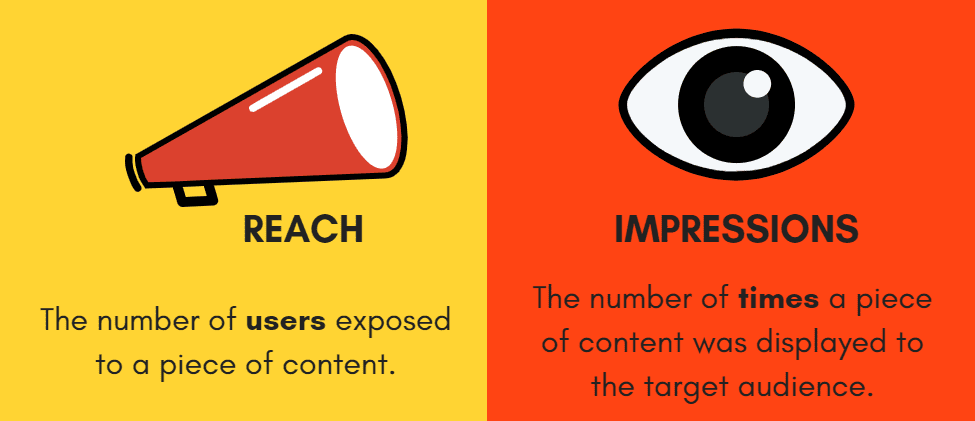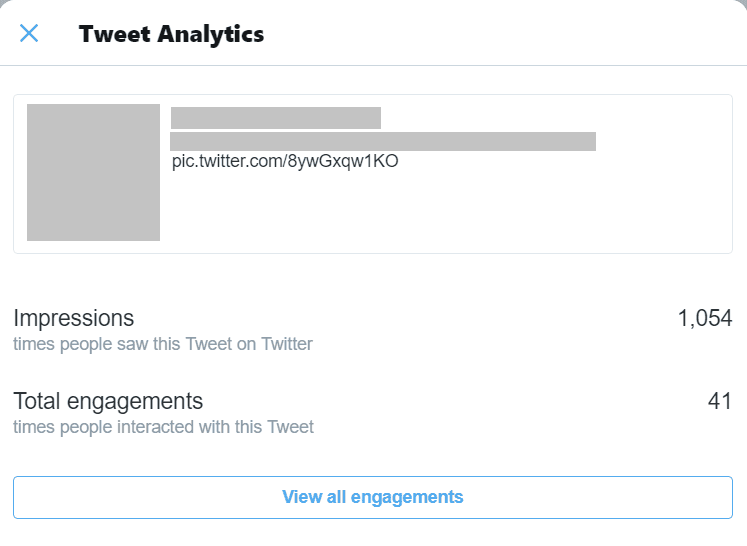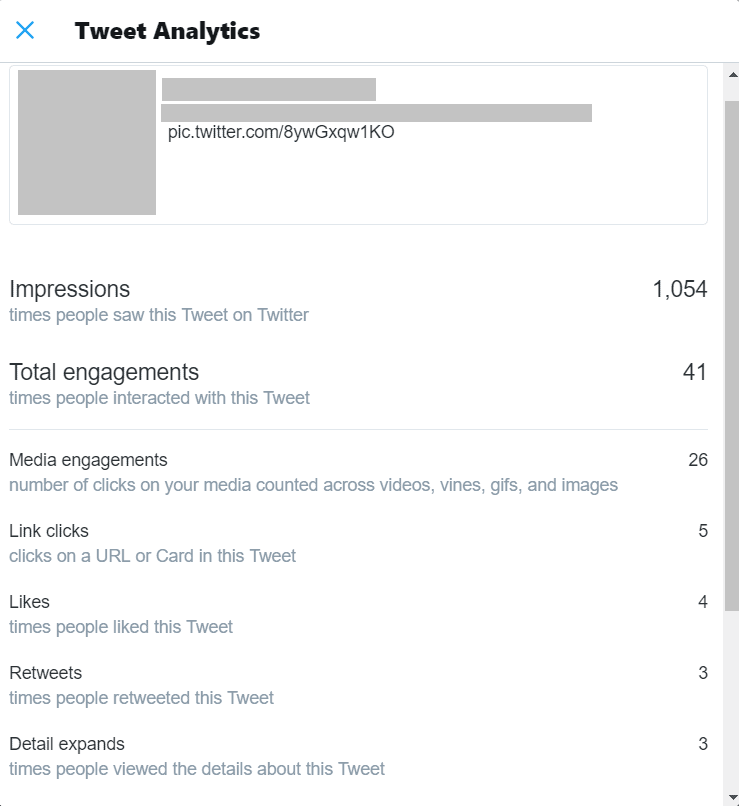Reach vs. Impressions is a common dilemma causing confusion amongst marketers and social media users alike.
Social media metrics like ‘reach’ and ‘impressions’ have become marketing buzzwords – everyone is talking about them, but not all understand their essence and, quite frankly, a lot of the time, people use these words interchangeably.
So, understanding the basics, or in this case, the difference between reach and impressions is a good starting point for assessing your campaign success and optimizing your social media strategy.
Let’s jump right in and take a look at what are the differences between these two basic metrics and what this means for your business.
Social media marketers often use reach and impressions as key metrics to track content performance. But what exactly do these metrics mean, and how are they different?
In this guide I’ll explain social media reach vs impressions why they matter, and how to track them across platforms like Facebook, Instagram, Twitter, and more.
Defining Reach and Impressions on Social Media
Reach and impressions sound similar but they measure different things
-
Reach refers to the total number of unique users who saw your content. For example, if your Instagram Story was viewed by 5,000 different accounts, you’d have a reach of 5,000.
-
Impressions count the total number of times your content was displayed, including repeat views by the same people. If your Facebook post was loaded in user feeds 8,000 times, your impressions would be 8,000.
So impressions can be higher than reach if people view your content multiple times. High impressions indicate your posts are memorable and engaging to your audience.
These definitions stay mostly consistent across social platforms, with some minor variations:
-
On Facebook, reach is the number of unique people who saw content from your Page. Impressions include views in feeds, Stories, search, etc.
-
Instagram counts reach as unique accounts that viewed your posts or Stories. Impressions include all views.
-
Twitter has impressions but not reach. Impressions are times a Tweet appeared in feeds or search.
-
YouTube tracks impressions as thumbnail views. Reach isn’t calculated.
-
LinkedIn has post impressions and profile views for reach.
Why Track Reach and Impressions?
As top-of-funnel metrics, reach and impressions indicate how well you’re distributing content and growing your audience.
Reach shows your potential to acquire new followers and build awareness. If your reach declines, it could mean your content isn’t appealing to new people.
Impressions reflect engagement and loyalty. More impressions per post signal your existing audience finds you valuable.
Weighing reach vs impressions depends on your goals:
-
Prioritize reach to scale your following and get discovered by new users.
-
Prioritize impressions to serve your current audience with relevant, high-quality content.
When just starting out on social media, focus on driving up both metrics. Later you can shift to more conversions and sales if desired.
How to Track Reach and Impressions by Platform
Most social platforms provide built-in analytics to view data on reach and impressions. Check out how to find these metrics on each:
In Facebook Analytics or Ads Manager, view:
- Reach: People reached
- Impressions: Post reach or Impressions
You can also see impressions for paid ads.
Under Instagram Insights:
- Reach: Accounts reached
- Impressions: Impressions
Filter by timeframe like 7, 30 or 60 days.
On your Twitter analytics page:
- Impressions: Total impressions
Twitter doesn’t have a dedicated reach metric.
For each post you’ll see:
- Impressions: Post impressions
To estimate reach, check your profile views.
YouTube
In YouTube Studio, find:
- Impressions: Impressions
Reach isn’t calculated. Views show how many times your video was watched.
How to Track with Social Media Management Tools
For a marketer managing multiple social media accounts, analytics platforms like Sprout Social, Hootsuite, and Agorapulse can provide a centralized dashboard to monitor reach and impressions.
Benefits include:
-
Cross-channel data: See performance holistically across all networks.
-
Custom reporting: Build visual reports with charts and graphs.
-
Exportable insights: Download analytics to share across teams and stakeholders.
-
Audience demographics: Break down reach and impressions by location, age, gender.
-
Historical trends: Look back at long-term changes and growth.
Weighing Reach vs. Impressions for Your Goals
When assessing your social strategy, take both reach and impressions into account.
To grow your audience, prioritize expanding reach. Set goals around total accounts reached, and post at times that help you engage new users.
To engage your current followers, drive up impressions per post. Set goals around average or total impressions. Post content tailored to your audience’s needs and interests.
You don’t have to choose just one metric. An ideal social media presence combines wide reach with relevant content that compels multiple views.
Also consider how reach and impressions feed into larger business goals like:
- Increasing website traffic
- Growing email list sign-ups
- Boosting online sales
- Raising brand awareness
Analyze which posts and tactics best support your bottom line. Connect social analytics to broader conversion tracking to see your ROI.
Key Takeaways for Monitoring Reach vs. Impressions
-
Reach counts the unique users who saw your content while impressions count total views.
-
Benchmark and track both over time to assess audience growth and loyalty.
-
Use platform analytics and social media tools to collect cross-channel data.
-
Weigh reach vs. impressions based on your goals to expand audience or drive engagement.
-
Consider the bigger picture of conversions and ROI beyond vanity metrics.
Knowing your reach and impressions is crucial for any social media marketer. Measure these metrics consistently to see how well your strategy is performing and what improvements could help take it to the next level.
What other tips do you have for making the most of reach and impressions data? Share your thoughts in the comments below!

What after Reach and Impressions: Other social media metrics to track

You can tell a lot about the relevance of your message by tracking reach and impressions, but usually, that’s not enough.
Reach and impressions are just a starting point in figuring out the way to optimise your campaigns for the two metrics that have the most significant impact on your business: engagement and conversions.
Every social media campaign has the ultimate goal of raising awareness and starting conversations with the target audience by increased engagement.
If reach and impressions are high, but people don’t engage with the content be it in the form of likes, shares, or replies, it’s safe to assume that either something is wrong with the framing of the message or the targeting is off.
Furthermore, looking at reach and impressions in isolation can tell you nothing about your social media ROI.
To get a better feel for your advertising spend and return of investment, you need to juxtapose your reach with your conversions and revenue.
This way, you will be able to calculate the average revenue and conversions per user reached – which are much more concrete metrics that have a direct impact on your business success.
So, what’s the verdict?
Reach, or impressions? What’s more important to track?
It’s a simple question – with no simple answer.
In this article, we explained how both reach and impressions play an important part in your social media marketing strategy.
But, just like with other metrics, the one you decide to focus on will depend solely on your current marketing objectives.
Hopefully, after reading this article you are able to make a distinction.
Related Article:
Twitter Reach vs. Twitter Impressions
Now take a look at this .

When you access the analytics of a tweet (be it via the web or the Twitter mobile app), you will notice that you can see impressions and total engagements, but there’s no number that shows reach.
Even if you expand the list and choose to “view all engagements,” you will get insight into various metrics like media engagements, retweets, likes, link clicks, and detail expands, but still, ‘reach’ won’t be part of the list.

This is so because Twitter does not track reach.
You can see the impressions per tweet, or collective impressions for all your tweets in a given time frame, but you won’t be able to access reach – that is to say, unless you use a third-party analytics tool.
Related Topic: Top 25 social media analytics tools every marketer should use
If you do use a third-party app to gain access to detailed Twitter analytics reports, then reach will show you the size of the audience you have reached with your tweets – just like with other social media platforms.

Twitter Impressions show the views of your tweets, or the number of times your Twitter content has shown up on someone’s feed, in search results, or to someone’s followers as a result of this someone interacting with your tweet.

Impressions don’t show if your tweet has been seen via third-party platforms, via a text preview or as an embed on a website.
Tweet impressions show the strength of your brand presence. Most likely you will have to pair these insights with other metrics such as engagement to get an accurate idea of the relevance of your content.
What are social media impressions and social media reach?
What is the difference between reach and impressions?
In general, reach measures the total number of people who saw your content. Impressions measure how many times they viewed it. But these definitions can vary by platform. Which is better, reach or impressions? If you care about growing as large an audience as possible, reach might be better.
What is the difference between reach and impressions in social media?
When it comes to social media, understanding the distinction between reach and impressions is essential. Reach refers to the number of unique individuals who have seen your content, representing the potential audience size reached by your posts. In other words, it measures how many people have been exposed to your content.
How important are reach and impressions in social media marketing?
Reach and impressions always matter, but they might be even more important at the start of your social media journey. Once plenty of people are seeing your content, you might choose to focus on more mid- to bottom-funnel metrics. Those include engagement, clicks, or conversions.
How many impressions does a social media ad have?
If your ad was displayed 500 times on social media, your impressions would be 500. Impressions are defined by the total number of people your content is visible to. Reach, on the other hand, refers to the number of people who choose to see your content and engage with it through likes, comments, or shares.